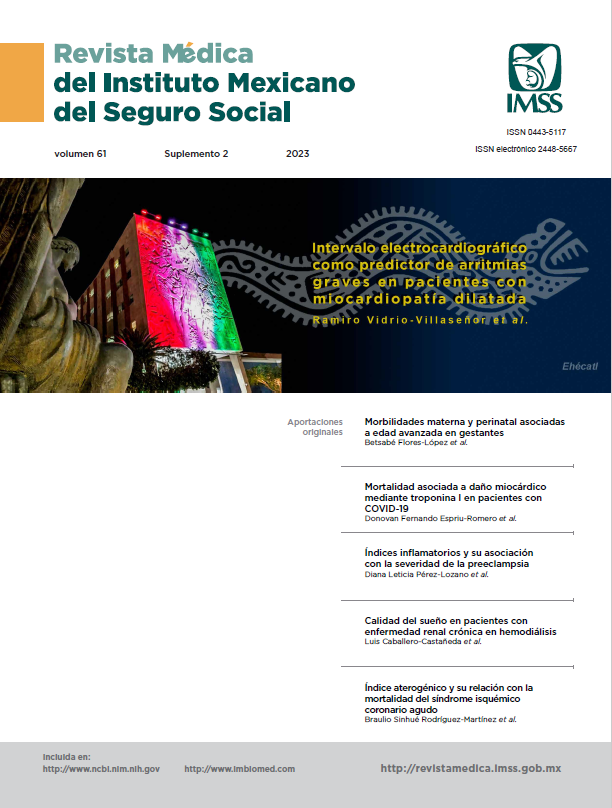Índices inflamatorios durante la inducción a la remisión de leucemia aguda pediátrica
##plugins.themes.themeEleven.article.main##
Palabras clave
Leucemia Linfoide, Inflamación, Pronóstico, Mortalidad, Pediatría
Resumen
Introducción: los índices inflamatorios pueden reflejar la severidad de padecimientos graves como la leucemia aguda (LA), con lo que pueden predecir la mortalidad.
Objetivo: evaluar el valor pronóstico de mortalidad de los índices inflamatorios durante la etapa de inducción a la remisión en pacientes con LA pediátrica.
Material y métodos: estudio observacional, longitudinal, analítico y retrolectivo. Se incluyeron pacientes de 0 a 17 años, con diagnóstico reciente y confirmado de LA, que contaron con citometría hemática basal (al diagnóstico, antes del inicio de tratamiento) y final (al término de la inducción a la remisión o en los casos de defunción, en el periodo previo a este desenlace).
Resultados: incluimos 78 pacientes, 67 con leucemia linfoblástica aguda (LLA) y 11 con leucemia mieloblástica aguda (LMA), con 11 y 2 defunciones, respectivamente. En la LLA ningún índice mostró puntos de corte significativos para distinguir muertes. En la LMA, los índices cuyos puntos de corte distinguieron a los pacientes que fallecieron en la medición basal fueron el índice monocito linfocito (IML) ≥ 3.11 (sensibilidad [S] 100%, especificidad [E] 66.67%, AUC 0.8333, p 0.03) y en la medición final, el índice neutrófilo linfocito (INL) ≥ 1.30 y el IML ≥ 0.57 (ambos con S 100% y E 88.89%, AUC 1.0, p < 0.00001) y el índice inmunosistémico (IIS) ≥ 246612 (S 100%, E 88.89%, AUC 0.9444, p < 0.0001). Con análisis bivariado solo este último mostró incremento del riesgo de mortalidad (p = 0.02)
Conclusiones: el IML basal y el INL, IML e IIS finales son índices inflamatorios pronósticos de mortalidad en pacientes con LMA en inducción a la remisión.
Referencias
Hunger S, Mullighan C. Acute Lymphoblastic Leukemia in Children. N Engl J Med. 2015;373(16):1541-52. doi: 10.1056/NEJMra1400972.
Instituto Nacional de Salud Pública. Leucemia infantil; México: INSP; 2021. Disponible en: https://insp.mx/assets/documents/webinars/2021/CISP_Leucemia.pdf.
Sekeres M, Gerds A. Mitigating Fear and Loathing in Managing Acute Myeloid Leukemia. Seminars in Hematology. 2015;52(3):249-55. doi: 10.1053/j.seminhematol.2015.03.009.
4.Smith M, Altekruse S, Adamson P, et al. Declining childhood and adolescent cancer mortality. Cancer. 2014;120(16):2497-506. doi: 10.1002/cncr.28748.
National Cancer Institute. Surveillance, Epidemiology, and End Results Program: Cancer Stat Facts: Leukemia — Acute Myeloid Leukemia (AML). Bethesda, Md: NCI, DCCPS, Surveillance Research Program; 2020. Disponible en: https://seer.cancer.gov/statfacts/html/leuks.html.
González-Salas WM, Olarte-Carrillo I, Gutiérrez-Romero M et al. Frecuencia de leucemias agudas en un hospital de referencia. Rev Med Inst Mex Seguro Soc. 2017;50(2):167-71. Disponible en: http://revistamedica.imss.gob.mx/editorial/index.php/revista_medica/article/view/1219/1865.
Aguilar-Hernández M, Fernández-Castillo G, Núñez-Villegas N et al. Principales causas de mortalidad durante la fase de inducción a la remisión en los pacientes pediátricos con leucemia linfoblástica aguda. Rev Med Inst Mex Seguro Soc. 2017;55(3):286-91. Disponible en: http://revistamedica.imss.gob.mx/editorial/index.php/revista_medica/article/view/313/2041.
Torres Courchoud I, Pérez Calvo JI. Biomarcadores y práctica clínica. Anales Sis San Navarra. 2016;39(1):5-8. Disponible en: https://scielo.isciii.es/scielo.php?script=sci_arttext&pid=S1137-66272016000100001&lng=es.
Che-Morales JL, Cortes-Telles A. Índice neutrófilo/linfocito como biomarcador sérico asociado con neumonía adquirida en comunidad. Rev Med Inst Mex Seguro Soc. 2018;56(6):537-43. Disponible en: http://revistamedica.imss.gob.mx/editorial/index.php/revista_medica/article/view/1711/3465.
Hwang S, Shin T, Jo I, et al. Neutrophil-to-lymphocyte ratio as a prognostic marker in critically-ill septic patients. Am J Emerg Med. 2017;35(2):234-239. doi: 10.1016/j.ajem.2016.10.055.
Martínez-Urbistondo D, Beltrán A, Beloqui O et al. El índice neutrófilo/linfocito como marcador de disfunción sistémica endotelial en sujetos asintomáticos. Nefrología. 2016;36(4):397-403. doi: 10.1016/j.nefro.2015.10.018.
Karagoz I, Yoldas H. Platelet to lymphocyte and neutrophil to lymphocyte ratios as strong predictors of mortality in intensive care population. Revista da Associação Médica Brasileira. 2019;65(5):633-6. doi: 10.1590/1806-9282.65.5.633.
Vasquez L, León E, Beltran B, et al. Pretreatment Neutrophil-to-Lymphocyte Ratio and Lymphocyte Recovery: Independent Prognostic Factors for Survival in Pediatric Sarcomas. J Pediatr Hematol Oncol. 2017;39(7):538-46. doi: 10.1097/MPH.0000000000000911.
Huang Z, Fu Z, Huang W, et al. Prognostic value of neutrophil-to-lymphocyte ratio in sepsis: A meta-analysis. Am J Emerg Med. 2020;38(3):641-7. doi: 10.1016/j.ajem.2019.10.023.
Seng D, Fang Q, Li P, et al. Prognostic Value of the Pretreatment Neutrophil-to-Lymphocyte Ratio in Pediatric Parotid Cancer. Frontiers in Pediatrics. 2019;7. doi: 10.3389/fped.2019.00207.
Lagunas-Alvarado M, Mijangos-Huesca FJ, Terán-González JO, et al. Systemic immune inflammatory index in sepsis. Med Int Mex. 2017;33(3):303-9. Disponible en: https://www.scielo.org.mx/pdf/mim/v33n3/0186-4866-mim-33-03-00303.pdf.
Basbus L, Lapidus MI, Martingano I et al. Índice neutrófilo-linfocito como factor pronóstico de COVID-19. Medicina (B. Aires). 2020; 80(Suppl 3):31-6. Disponible en: http://www.scielo.org.ar/scielo.php?script=sci_arttext&pid=S0025-76802020000500005&lng=es.
Beltran BE, Aguilar C, Quiñones P, et al. The neutrophil-to-lymphocyte ratio is an independent prognostic factor in patients with peripheral T-cell lymphoma, unspecified. Leuk Lymphoma. 2016;57(1):58-62. doi: 10.3109/10428194.2015.1045897.
Porrata L, Ristow K, Habermann T, et al. Predicting survival for diffuse large B-cell lymphoma patients using baseline neutrophil/lymphocyte ratio. Am J Hematol. 2010;85(11):896-9. doi: 10.1002/ajh.21849.
Stefaniuk P, Szymczyk A, Podhorecka M. The Neutrophil to Lymphocyte and Lymphocyte to Monocyte Ratios as New Prognostic Factors in Hematological Malignancies – A Narrative Review. Cancer Manag Res. 2020;12:2961-2977. doi: 10.2147/CMAR.S245928.
Ramos-Peñafiel C, Santos-González B, Flores-López E, et al. Usefulness of the neutrophil-to-lymphocyte, monocyte-to-lymphocyte and lymphocyte-to-platelet ratios for the prognosis of COVID-19-associated complications. Gac Med Mex. 2020;156(5):405-11. doi: 10.24875/GMM.M20000428.
Forget P, Khalifa C, Defour J, et al. What is the normal value of the neutrophil-to-lymphocyte ratio? BMC Research Notes. 2017;10(1). doi: 10.1186/s13104-016-2335-5.
Djordjevic D, Rondovic G, Surbatovic M, et al. Neutrophil-to-Lymphocyte Ratio, Monocyte-to-Lymphocyte Ratio, Platelet-to-Lymphocyte Ratio, and Mean Platelet Volume-to-Platelet Count Ratio as Biomarkers in Critically Ill and Injured Patients: Which Ratio to Choose to Predict Outcome and Nature of Bacteremia? Mediators Inflamm. 2018;2018:3758068. doi: 10.1155/2018/3758068.
Celik B, Nalcacioglu H, Ozcatal M, et al. Role of neutrophil-to-lymphocyte ratio and platelet-to-lymphocyte ratio in identifying complicated appendicitis in the pediatric emergency department. Ulus Travma Acil Cerrahi Derg. 2019;25(3):222-228. English. doi: 10.5505/tjtes.2018.06709.
Chen JH, Zhai ET, Yuan YJ, et al. Systemic immune-inflammation index for predicting prognosis of colorectal cancer. World J Gastroenterol. 2017;23(34):6261-72. doi: 10.3748/wjg.v23.i34.6261.


